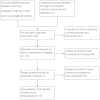Is hyperuricemia an independent risk factor for new-onset chronic kidney disease?: A systematic review and meta-analysis based on observational cohort studies
- PMID: 25064611
- PMCID: PMC4132278
- DOI: 10.1186/1471-2369-15-122
Is hyperuricemia an independent risk factor for new-onset chronic kidney disease?: A systematic review and meta-analysis based on observational cohort studies
Abstract
Background: Hyperuricemia has been reported to be associated with chronic kidney disease (CKD). However whether an elevated serum uric acid level is an independent risk factor for new-onset CKD remained controversial.
Methods: A systematic review and meta-analysis using a literature search of online databases including PubMed, Embase, Ovid and ISI Web/Web of Science was conducted. Summary adjusted odds ratios with corresponding 95% confidence intervals (95% CI) were calculated to evaluate the risk estimates of hyperuricemia for new-onset CKD.
Results: Thirteen studies containing 190,718 participants were included. A significant positive association was found between elevated serum uric acid levels and new-onset CKD at follow-up (summary OR, 1.15; 95% CI, 1.05-1.25). Hyperuricemia was found be an independent predictor for the development of newly diagnosed CKD in non-CKD patients (summary OR, 2.35; 95% CI, 1.59-3.46). This association increased with increasing length of follow-up. No significant differences were found for risk estimates of the associations between elevated serum uric acid levels and developing CKD between males and females.
Conclusions: With long-term follow-up of non-CKD individuals, elevated serum uric acid levels showed an increased risk for the development of chronic renal dysfunction.
Figures






References
-
- Levey AS, Atkins R, Coresh J, Cohen EP, Collins AJ, Eckardt KU, Nahas ME, Jaber BL, Jadoul M, Levin A, Powe NR, Rossert J, Wheeler DC, Lameire N, Eknoyan G. Chronic kidney disease as a global public health problem: approaches and initiatives - a position statement from kidney disease improving global outcomes. Kidney Int. 2007;72:247–259. - PubMed
-
- Tanner RM, Brown TM, Muntner P. Epidemiology of obesity, the metabolic syndrome, and chronic kidney disease. Curr Hypertens Rep. 2012;14:152–159. - PubMed
-
- Pyram R, Kansara A, Banerji MA, Loney-Hutchinson L. Chronic kidney disease and diabetes. Maturitas. 2012;71:94–103. - PubMed
-
- Levin A. Identification of patients and risk factors in chronic kidney disease–evaluating risk factors and therapeutic strategies. Nephrol Dial Transplant. 2001;16(Suppl 7):57–60. - PubMed
-
- Becker MA, Jolly M. Hyperuricemia and associated diseases. Rheum Dis Clin North Am. 2006;32:275–293. v-vi. - PubMed
Publication types
MeSH terms
LinkOut - more resources
Full Text Sources
Other Literature Sources
Medical

